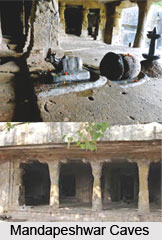 History of Mandapeshwar Caves is dealing with the old and ancient history of India and the conglomeration of Hinduism and Buddhism of old times. The formation of the Mandapeshwar Caves dated at about 1500 to 1600 years ago.
History of Mandapeshwar Caves is dealing with the old and ancient history of India and the conglomeration of Hinduism and Buddhism of old times. The formation of the Mandapeshwar Caves dated at about 1500 to 1600 years ago.
Mandapeshwar Caves are believed to have been built approximately 1500 to 1600 years ago, nearly around the same time as Jogeshwari caves (which were built between 520 and 550 AD).
Most of the early rock-cut temples and rock-art in India was created by Buddhist monks. The monks were the missionaries of the revolutionary message of the Buddha and the best places to spread the new message were the nodes of trade routes. Maharashtra and many of its hills in the Western Ghats Mountain Range in India fit their purpose.
The monks would dig out prayer halls or chaitya-grihas in the caves, while building votive stupas and dwelling places for themselves. Here they would meditate and influence the passing traders and anyone else. The hills around Mumbai were at the juncture of the sea trade routes. During the occupation of the khaneri caves, the Buddhist monks found another location where they created a hall of paintings. The cave was created by the Buddhist monks and then they hired travelling Persians to paint. The Buddhist monks asked the Persians to paint the life of Lord Shiva or Mahadeva.
The sculptures of Mandapeshwar Caves in these caves are estimated to have been carved out at the same period as of those seen in the more splendid Jogeshwari Caves. It contained the largest Mandapa and a prominent Garbagriha.
This cave has seen through time during World War 2. The General people used to stay there and the Portuguese soldiers used it as a place of prayer. These caves were witness to a series of invasions in the surrounding areas by different rulers and each time the caves were used for a different reason, sometimes even for things like housing by the armies or sometimes by refugees. During this period of early colonial era, the monolithic paintings were badly defaced. After the invasion of the Maratha Empire in India, in this area in the year 1739, the entire area was pillaged and burnt. This included the college, church and every other building around. For years this area was deserted, but now this caves are reserved by Archaeological Survey of India.
Most of the Mandapeshwar Caves can be seen on the walls now are just broken down remains, which are sad reminders of its glorious past. The church and its graveyard are situated above the cave precincts. There are ruins of an old structure above the caves. These ruins of Mandapeshwar Caves belonged to a much older church built in 1544. This ruin of Mandapeshwar Caves is also under protection of Indian Archaeology Society.
Mandpeshwer caves of Maharashtra have sculptures of Nataraja, Sadashiva and a splendid sculpture of Ardhanarishvara. It also has Lord Ganesha, Lord Brahma and Lord Vishnu statuettes. These works in Mandapeshwar Caves depicted the mythical tales of the Hindu Gods and Goddesses.



















